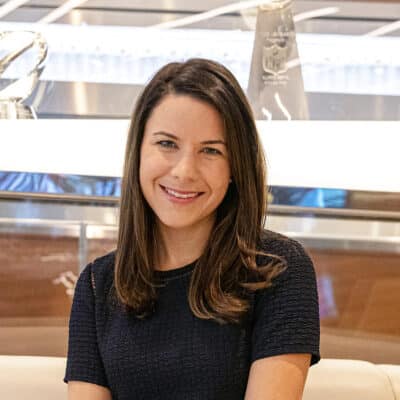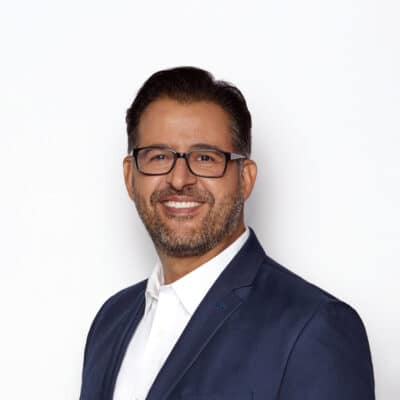|
Getting your Trinity Audio player ready...
|
Hispanics across the globe are known for their passion for fútbol (soccer), but the community’s enthusiasm for athletics extends far beyond just that one sport. The National Football League (NFL) has made an effort to bring fútbol americano to a wider audience, growing its Latino fan base substantially over the past decade.
The biggest event for the football world is, of course, the Super Bowl, which has been aired on Spanish-language cable networks in previous years. But such networks can only reach so many members of the global audience, which is why, for the 2022 Super Bowl, the NFL decided to make a change: it partnered with Telemundo to air the game on a Spanish-language broadcast network for the first time in history.
The Telemundo broadcast—which featured a dedicated Spanish-language announcing team and multiple crews that conducted culturally relevant interviews, along with an array of other Latino-relevant content—became the highest-rated Spanish-language non-soccer sports event in over a decade. Telemundo’s broadcast eclipsed the viewership of previous Spanish-language Super Bowl executions. It was the most-watched NFL game in Spanish-language history, registering a record-setting average of 1.9 million total viewers.
Super Bowl LVI also registered big wins online. It delivered the most-streamed NFL game on Telemundo and was the number-two social telecast across all television, second only to NBC’s English-language telecast of the Super Bowl.
It’s an incredible achievement, and a milestone in the partnership between the NFL and Telemundo. The two companies have already decided to continue partnering on football-related content events—Telemundo will serve as the home for Spanish-language broadcasts of Sunday Night Football and NBC playoff games for the next thirteen years—and have a host of other plans in the works.

“I knew in my first week at the NFL that I wanted to make the Super Bowl and other games as accessible to Spanish speakers as possible.”
Amanda Herald
Different Paths, One Passion
Amanda Herald—vice president of marketing strategy, insights, and planning at the NFL—and Eli Velazquez—executive vice president of sports content at NBCUniversal Telemundo—are two of the principal architects of this successful partnership. While their journeys differ, both executives possess a deep passion for finding new ways to serve a Spanish-speaking audience—and as well as a deep commitment to their respective sports fandoms.
Growing up in Miami, Herald followed all things related to the Miami Hurricanes, the Miami Dolphins, the Miami Heat. She attended any sports event she could get her parents to bring her to. Her grandmother, however, was more concerned about her granddaughter’s Spanish-language skills. A former public school Spanish teacher, Herald’s grandmother worked hard to perfect her granddaughter’s pronunciation and always chided Herald for her inability to “roll her Rs,” less commonly known as an apical-alveolar trill.
Herald went straight to the NFL when she graduated from college and has stayed there for the last thirteen years of her career, earning numerous promotions along the way. “I knew in my first week at the NFL that I wanted to make the Super Bowl and other games as accessible to Spanish-speakers as possible,” Herald says. “I always think about my grandmother, who didn’t have access to much Spanish-language content growing up.”
Velazquez, on the other hand, was born and raised in the Bronx. But his NYPD police officer father soon tired of the winters in the Northeast, and when Velazquez was fourteen, his father moved the family back to his and his wife’s home country of Puerto Rico.
Though he felt like an outsider, Velazquez was determined to fit in. It was that same attitude and gumption that inspired the young sports fan’s professional dreams. Velazquez was intent on becoming the “Hispanic Chris Berman”—he not only appreciated Berman’s signature style and energy, but aspired to have an impact as a Latino in the sports media industry.
Instead, Velazquez found success on the other side of the camera. He spent seven years as a sports producer and editor at Univision before joining the team at Telemundo, where he’s worked for the last twenty-three years. “Like Amanda, I always wanted to make sure that my efforts were facilitating a great experience for Spanish-speakers like all of the people on that Caribbean island where I spent so much time,” he says. “This partnership is the epitome of why I set out to do what I do and why I want to have an impact on this community.”

“There’s so much more we can do. I know that I’m looking forward to what will be a long and fruitful relationship.”
Eli Velazquez
Accessibility Is Key
While Spanish-language content is important on a personal level to executives like Velazquez and Herald, the business case for that content cannot be ignored. As Velazquez points out, the median age of Hispanics in the US is twenty-nine years old, making Hispanics the youngest multicultural group in the country. “This is a demographic that spends 113 hours a week on their mobile devices,” he explains. “They’re already early technology adopters. If you don’t speak to them in both Spanish and English, you’re not addressing the future of your business.”
“That’s exactly why we’re growing our international programs as well,” Herald chimes in. “Along with our broadcasts, we’re partnering with our players and our thirty-two clubs to help promote growth across the world. From Mexico to Spain, we have deeply passionate pockets of growth that are growing exponentially.”
Many NFL teams are investing in developing international fan bases: in Mexico alone, nine NFL clubs are launching fan development and commercial efforts.
As both executives emphasize, this cross-border approach is also an opportunity to unite more people who have shared experiences in the language of their choice. And by the language of their choice, they don’t just mean content with closed captions or voice-overs. “It’s about full, custom production that’s focused on what will be fun and informative for the audience,” Herald says. In fact, that’s exactly what Telemundo and NBC Sports did with the Super Bowl: they established broadcast locations all over LA to provide Spanish-language pregame and postgame content in addition to the game itself.
“It was great to see feedback from people who speak both languages who were torn about which broadcast they wanted to watch,” Velazquez says. “We always think of our audience as the ‘200 percenters:’ the portion of our audience that considers themselves 100 percent American and 100 percent Hispanic. They exist in both worlds, and it’s the kind of reaction you really love to hear.”
While the partnership between NFL and Telemundo has already led to great success, Herald says it’s a foundation for other much-needed changes in the sports world. According to her, 17 percent of NFL fans identify as Latino—but Latinos only account for 10 percent of viewership.
“Through this partnership, we have the opportunity to deepen and expand our relationship going forward, and it’s truly for the benefit of growing fans everywhere,” Herald says.
Velazquez agrees, and lauds Telemundo Deportes President Ray Warren for continuing to find new ways to serve the company’s audience.
“Ray was instrumental in ensuring this partnership was connected at all levels of the organization,” Velazquez says. “As Amanda continues working with their thirty-two clubs, and we work with all the stations and network programming divisions, there’s so much more we can do. I know that I’m looking forward to what will be a long and fruitful relationship.”

